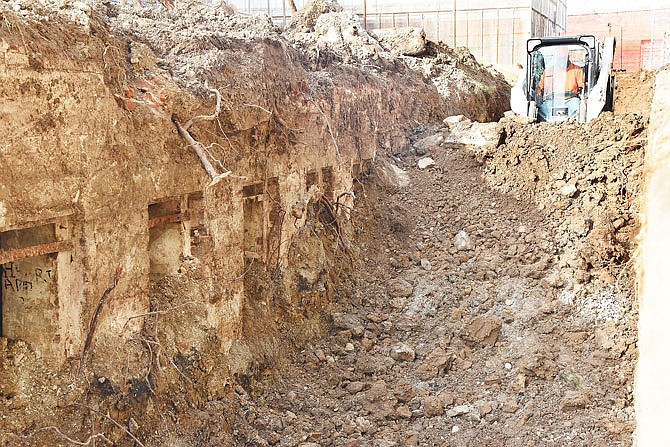A new layer of history at Missouri State Penitentiary began to see the light of day last week as crews worked to excavate a block of cells buried underground.
The Jefferson City Convention and Visitors Bureau and Missouri Office of Administration's Division of Facilities Management, Design and Construction are working to uncover the cells with the hopes of adding them to future tours of the historic site.
With a small delay because of the snow earlier in the week, crews have been at work digging out the cells. The area around the buried cells, between Housing Units 2 and 3, is full of mud covered in tracks from a skid loader.
Back and forth, the skid loader drove down a muddy slope along the side of Housing Unit 3 to the cells, filled up with dirt, and returned to the top to unload. As the dirt was taken away, more doors were revealed.
Parts of nine cell doorways could be seen Friday afternoon, some completely visible while others just peeked over the top of the dirt. The wooden doors that once hung there have long since rotted away. Even the most cleared doorways were about half-full of dirt, bricks and stones, with entrance to the cells impossible for the time being.
Jefferson City Ward 5 Councilman Mark Schreiber has a unique connection to those buried cells.
Schreiber worked at MSP for many years starting in 1968, and he was working as the assistant to the prison's director of adult institutions and the chief investigator when the cells were found.
Due to a court order, contractors were working between 1984-85 on providing a recreation yard near Housing Unit 3 for prisoners in administrative segregation and those awaiting capital punishment, or "death row" inmates.
"When the contractor came in and started the process of excavation so they could pour the concrete, the contractor hit a solid mass which they hadn't anticipated," Schreiber said.
Intrigued, the crews dug further and discovered something surprising.
"I got a phone call from the warden at the time," Schreiber recalled. "The warden said, 'Mark, you need to come over here. I've got something to show you.'"
Schreiber arrived at the prison, camera in tow, and took the only known photos of the previously buried cells. As far as he knows, no one else was allowed to take photos.
"You could still read some of the numbers above the doors - the original numbers," Schreiber said.
They were known, at one point, as the Centennial Cells, although Schreiber isn't sure from where the name originates.
He recalled no one had ever mentioned the cells to him when he was working there, even people who had worked there for decades before he started in the 1960s.
"They had long been forgotten," Schreiber said.
It's estimated the cells were built sometime in the late 1840s as part of a two- or three-story building that was eventually torn down. If the cells were built when Schreiber believes they were, they are the oldest existing portion of building on the site - an honor which previously belonged to the famous Housing Unit 4, or A Hall, built in 1868.
"Back in the day when they were torn down, they didn't have jackhammers and all the mechanized equipment we have today," Schreiber said. "That all had to be done by hand, so they simply tore those cells down, and then when they got to that lower level, they just mounded it over with dirt."
Between Housing Units 2 and 3, Schreiber said, you can still see where the dirt was mounded up.
At the time, crews only uncovered one side of part of the block because they needed to keep going with the recreation yard.
Recently, crews were able to use ground-penetrating radar to determine there were other voids in the area, meaning there are likely more cells, Schreiber said.
Now, the CVB and OA are working to uncover the entire block.
When Schreiber and CVB Executive Director Diane Gillespie were searching for a way to enhance the MSP tours, uncovering the cells was a project both were excited to pursue.
"We thought that would be an interesting addition to the tours - another history," Schreiber said.
Schreiber is doing his part by using his knowledge and research to write the historical portion of the tour guide script for the new section of the tour.
Brittney Mormann, communications and film manager for the CVB, said they can't be sure to which tour or tours the cells will be added until the work is completed. CVB offers two- and three-hour history tours, several ghost tours and photography tours.
After the cells are excavated, which is expected to take around two weeks, a structural engineer will need to inspect the cells to determine if they will be safe to enter, Mormann said. The results will help determine if visitors will be able to go inside the cells during tours.
Phase one of the project, which includes the excavation and design of the cells, is estimated to cost around $45,000, funded by profit generated from the tours, Mormann said.
The excavation work is being done by Jeff Schnieders Construction.
CVB officials said they hope the cells will be added by the start of the next tour season, which typically begins in March.

